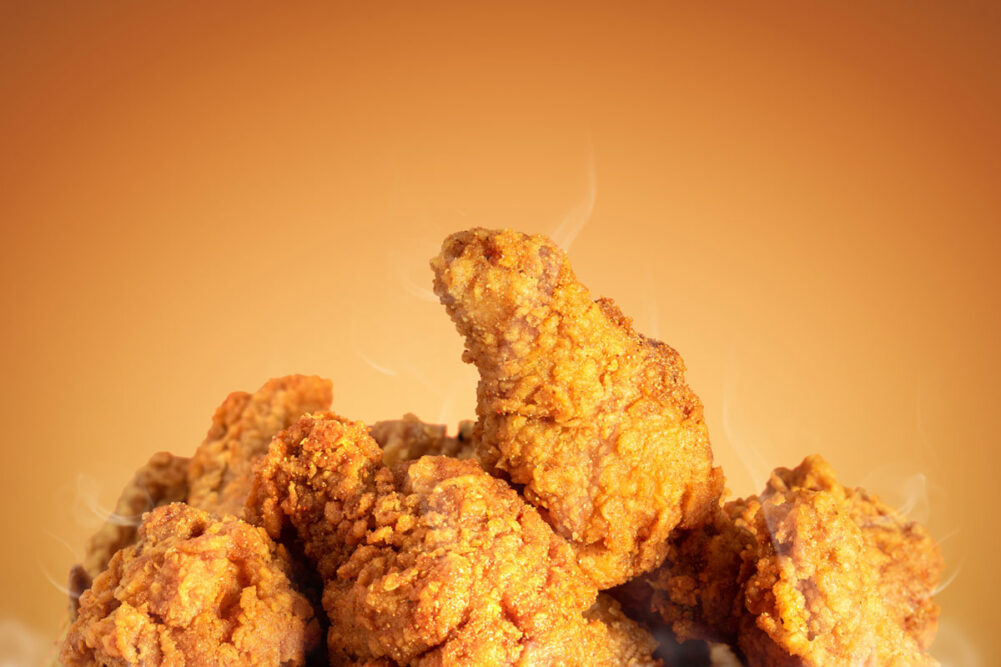CHICAGO — Everyday cheeses, meats and vegetables are transformed when they are breaded or battered with layers of crunch and flavor. Topical applications also are the familiar component of many varied plant-based products entering the marketplace.
Cajun-breaded New Wave Shrimp from New Wave Foods, Stamford, Conn., is a plant-based shrimp formulated with seaweed extract and mung bean protein that has the same bite, texture and taste of ocean shrimp, according to the company.
Monrovia, Calif.-based Myrtle Greens has a new vegan boneless chicken wings line for foodservice. The product features a light breading that enables the operator to add dry rub or marinade without compromising the crunchy outside.
Such coatings assist chefs with making “irresistible vegetables,” a top global menu trend for 2023, according to Unilever Food Solutions North America, Englewood Cliffs, NJ. When whole vegetables are the focal point of a dish, there’s opportunity to introduce new textures, contrasting flavors and unexpected combinations. Vegetables may be showcased as feel-good foods that have hints of being wild, pure and seasonal.
That’s what McCain Foods, Toronto, is doing with its new V’DGZ Shareables line that includes Bruss’lz and Cauli W’ngz. The former are lightly seasoned Brussels sprouts halves with a crispy crust, while the latter is a crispy crunch of lightly pickled cauliflower that may be served as is or tossed with a sauce.
All three innovations were recipients of a 2023 FABI Award from the National Restaurant Association Show. The accolade is given to the year’s most forward-thinking and creative new tastes that are driving trends in foodservice, according to the association. And whatever starts out of home eventually makes its way to the supermarket, with fully-cooked breaded and battered foods usually sold as frozen foods to best manage product integrity and shelf life.
Sol Cuisine, Mississauga, Ont., offers branded retail cauliflower wings, as well as plant-based formed wings. The brand also has a tempura-battered plant-based filet that flakes like white fish.
Perdue Foods, Salisbury, Md., offers Perdue Chicken Plus Snackers. The fully cooked bite-size snacks are formulated with a blend of chicken, chickpeas and cauliflower. They come in barbecue, Firecracker and pizza varieties, with a quarter cup of vegetables and 9 grams of protein in each serving. The seasonings are in the meaty center and the crunchy breading.
Delivering nutrition through crunch
Breading and batter technology invites innovators to add a dimension of character to foods. Formulating spices, herbs, seeds, nuts, and even fruit and vegetable particulates into breadings is a way to differentiate in the marketplace. Global flavor profiles also play well in this space.
Examples may include black sesame seed panko crumbed pork strips or gyro nuggets coated with pita crumbs. Battered and fried green tomatoes may become a fine-dining option with the proper garnish. And an umami-rich mushroom holds up just as well, if not better, with industrial frying.
To help parents feel better about serving their children nuggets multiple times per week, formulators are upgrading them with whole grain breadings, sometimes with hidden vegetables or extra fiber.
“We are seeing brands use whole grains or even ancient grains in tempura-style battered products, leveraging their ‘health halos’ to bring added nutritional appeal to this kid-friendly, convenient category,” said Conor Sullivan, senior technical services specialist, Cargill, Minneapolis. “Oil selection has a big impact on the finished products’ nutritional credentials, too. Here, canola oil, which is low in saturated fats, is a good choice.
“The big story in the breading and batter space remains the ongoing quest to make products crispier and to help them sustain that texture longer.”
That’s challenging, even with flash-freezing technology.
“Oil absorption is a common concern in this space; no one wants a soggy product,” said Melissa Machen, principal technical account manager, protein ingredients at Cargill. “To prevent fried products from absorbing too much oil, we often recommend incorporating corn dextrins into the formula. They create a protective film layer around the product, reducing oil pick up. Oil temperature also plays a big role in oil absorption. The right temperature can help prevent excess oil absorption.”
Courtney Schwartz, marketing director for Kemin Industries, Des Moines, Iowa, said, “Consumers love breaded and fried foods, but only when they are crispy on the outside, tender on the inside and have a satisfying, less greasy mouthfeel. Beyond this great-eating experience, consumers also want labels with ingredients they recognize.”
To assist, Kemin now offers fat-block technology. This clean label functional protein is designed for industrial battered, breaded and fried foods. The functional protein system forms a micro-barrier around items to inhibit frying oil from being absorbed into the breading. Depending on the coating system, fat uptake may be reduced up to 50%. Less moisture is also lost in the product during frying, which results in increased yield. There’s also a plant-based protein system for vegetarian and vegan applications.
The technology also is considered a processing aid by the USDA’s Food Safety and Inspection Service, and therefore does not require labeling when used with the same species, such as functional chicken protein on a breaded chicken nugget. There’s also a plant-based protein system for vegan applications.
“This fat-block technology provides manufacturers the opportunity to meet the label claims and product attributes consumers desire, while achieving greater yields,” Ms. Schwartz said.
Formulators also may want to explore air frying technologies to keep fat content low. There are some additional considerations with the process.
“We’re even seeing some manufacturers use this technology as part of their production process as a way to reduce fat,” Mr. Sullivan said. “Some oil is still incorporated into these systems — either directly in the breading/batter or as a quick spray coating — so you still get some of that indulgence, but the end-product will have a lot less fat than traditional nuggets, strips and patties. That said, because the oil is topical, factors like oxidation stability and flavor are especially important. Brands will have the best success with high-quality, premium oils that offer consistent color and a clean-flavor profile.”





